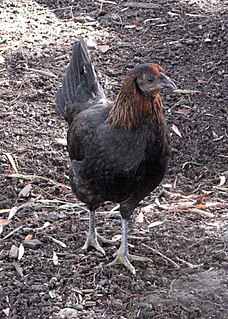
The American Game is an American breed of game fowl, chickens bred specifically for cockfighting. It has many color varieties, and may also be kept for ornament.
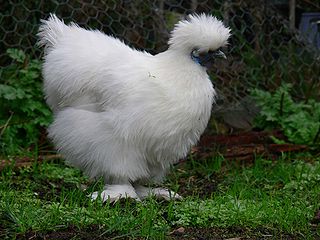
The Silkie is a breed of chicken named for its atypically fluffy plumage, which is said to feel like silk and satin. The breed has several other unusual qualities, such as black skin and bones, blue earlobes, and five toes on each foot, whereas most chickens only have four. They are often exhibited in poultry shows, and appear in various colors. In addition to their distinctive physical characteristics, Silkies are well known for their calm, friendly temperament. It is among the most docile of poultry. Hens are also exceptionally broody, and care for young well. Though they are fair layers themselves, laying only about three eggs a week, they are commonly used to hatch eggs from other breeds and bird species due to their broody nature.

The Cochin is a breed of large domestic chicken. It derives from large feather-legged chickens brought from China to Europe and North America in the 1840s and 1850s. It is reared principally for exhibition. It was formerly known as Cochin-China.
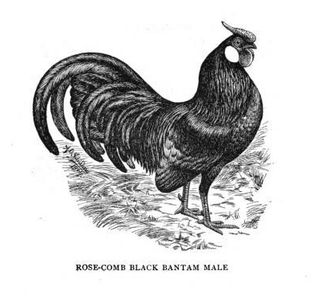
The Rosecomb is a breed of chicken named for its distinctive comb. Rosecombs are bantam chickens, and are among those known as true bantams, meaning they are not a miniaturised version of a large fowl. Rosecombs are one of the oldest and most popular bantam breeds in showing, and thus have numerous variations within the breed. An ornamental chicken, they are poor egg layers and not suited for meat production.

The Sebright is a British breed of bantam chicken. It is a true bantam – a miniature bird with no corresponding large version – and is one of the oldest recorded British bantam breeds. It is named after Sir John Saunders Sebright, who created it as an ornamental breed by selective breeding in the early nineteenth century.

The Appenzeller is a breed of chicken originating in Appenzell region of Switzerland. The Appenzeller comes in two varieties. The Spitzhauben variety, meaning "lacy bonnet", has a V-comb and feather crests in males and females. The word 'spitzhauben' derives from a ceremonial hat worn by the women in the Appenzeller region in Switzerland. The breed was imported into America by a doctor. The Barthuhner has a rose comb and no crest. Both types appear in either black, golden spangled and silver spangled plumage. They are mostly a show breed, but are decent egg layers. They lay small white eggs about 5 times per week.

The Buckeye is a breed of chicken originating in the U.S. state of Ohio. Created in the early 19th century, Buckeyes are the only standard breed recognized by the American Poultry Association (APA) that is known to have been developed by a woman. It is the only breed in the American Class to have a pea comb. Buckeyes are listed as "Watch" by The Livestock Conservancy. The breed's name is derived from Ohio's nickname of "Buckeye state". Their mahogany color is said ideally to resemble the seeds of the Ohio Buckeye plant. They are a dual-purpose chicken, known both for laying productivity and meat characteristics. Buckeyes are yellow-skinned chickens that lay brown eggs.

The Dutch Bantam is a breed of bantam chicken originating in the Netherlands. It is a true bantam, a naturally small bird with no related large fowl from which it was miniaturized. It is kept mainly for exhibition, and has been bred in many color varieties; it is a good layer of small eggs.

The Booted Bantam or Dutch Booted Bantam, Dutch: Sabelpoot, is a bantam breed of chicken. Its name is derived from the extravagant feathering on the feet and hock joints, which are called vulture hocks or "sabels" in Dutch. With no large fowl counterpart from which it was miniaturized, the Booted is one of the true bantams. Males usually weigh in at around 850 grams and females 750 grams. American standards dictate a smaller ideal size of 740 grams for males, and 625 for females.
The Marsh Daisy is a rare breed of chicken originating in Lancashire, England. Its name may be related to its origin in a marsh-like area, or that its large rose comb resembles the flower of the Marsh Daisy.
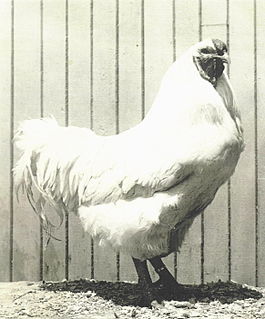
The Chantecler is a breed of chicken originating in Canada. The Chantecler was developed in the early 20th century, at the Abbey of Notre-Dame du Lac in Oka, Quebec. It is extremely cold-resistant, and is suitable for both egg and meat production.

The Barbu d'Anvers, Dutch: Antwerpse baardkriel, is a breed of bantam chicken from Belgium. It is a true bantam, and has no full-sized counterpart; males weigh about 700 grams and hens about 600 g. The Barbu d'Anvers is one of the oldest bantam breeds, and is thought to have originated in the province of Antwerp in northern Flanders. It is the only Belgian bantam breed not threatened with extinction. In the United States it may be called the Antwerp Belgian or Belgian Bearded d'Anvers.

The Rhode Island White is a breed of chicken originating in the U.S. state of Rhode Island. Despite their very similar names and shared place of origin, the Rhode Island White is a distinct breed from the Rhode Island Red. However, Rhode Island Reds and Whites can be bred together to create Red Sex Link hybrid chickens, such as the ISA Brown. In Australia, the Rhode Island White is regarded as a colour variety of the Rhode Island breed according to the Australian Poultry Standards.

The Delaware is a breed of chicken originating in the U.S. state of Delaware. It was once of relative importance to the U.S. chicken industry, but today is critically endangered. It is primarily suited to meat production but also lays reasonably well. It has plumage of a unique pattern, and is accepted into poultry standards for showing.

The Sultan is a breed of chicken originating in Turkey, belonging to the group of crested chicken. Its English moniker is directly culled from the original Turkish language name of Serai-Tavuk, which translates as "fowls of the Sultan". They have always been primarily ornamental, having been kept in the gardens of Ottoman sultanate. In the West they are bred for competitive showing as part of poultry fancy, and are generally a rare sight.
The Iowa Blue is a breed of chicken that originated near Decorah, Iowa in the early 20th century. Despite its name, the breed is not actually blue according to poultry standards. It is an exceedingly rare fowl, and is not recognized for showing by the American Poultry Association. They are a dual-purpose breed laying brown eggs and known to be good foragers.
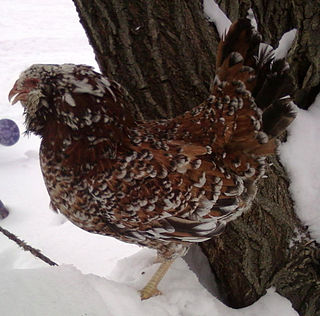
The Orloff is a breed of chicken named after Alexei Grigoryevich Orlov, a Russian Count. Reflecting this origin, it is sometimes called the Russian Orloff or simply Russian.

The Derbyshire Redcap is a breed of chicken originating in the English county of Derbyshire. The name "Redcap" derives from the breed's unusually large Rose-type comb. British breed standards dictate a length of more than 7 centimetres (3 inches) of length for a Redcap comb. It is covered in small, fleshy points, and has a distinct spike pointing backwards called a "leader". Combs, wattles and earlobes are all ideally bright red.

The Kraienkopp, Dutch: 'Twents Hoen', is a breed of chicken originating on the border region between Germany and the Netherlands. The latter of the two names is the Dutch language version, while the former is German. The Kraienkopp appears in two color varieties: Black-breasted Red and Silver. Males weigh 2.75 kilos, and females weigh 1.8 kilos. They have yellow skin and a small walnut-type comb.

The Golden Cascade is a breed of domestic duck developed in the United States. In 1979, David Holderread of Corvallis, Oregon set out to breed a duck that was fast growing, active, laid eggs well, and was auto-sexing. By the mid-1980s, the Golden Cascade was introduced to the market. It is not yet admitted to the American Poultry Association's Standard of Perfection.



















